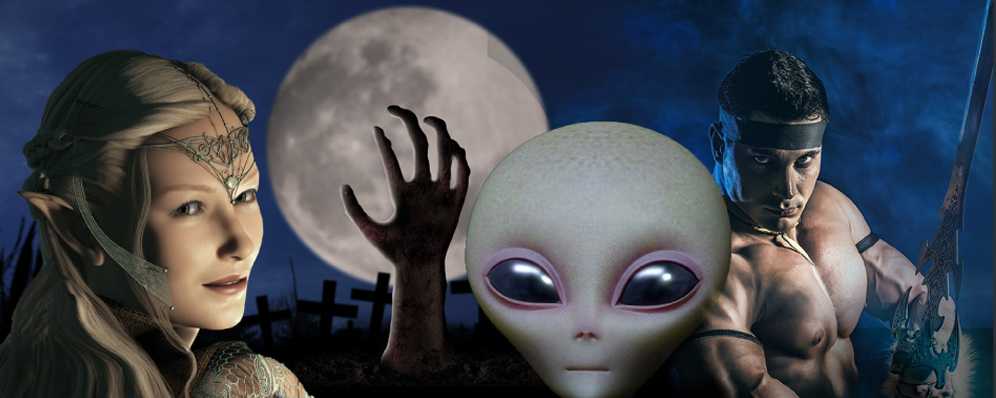Sub-genres of any kind can be difficult to nail down, but in the genres of fantasy and science fiction it’s not easy to even get them to hold still. The principle reason for this is that these two genres are often collectively called “speculative fiction” because they deal with the question “What if . . . ?” This leads not only to genre hybrids such as science fantasy, but to sub-genres that may be applied to either fantasy or science fiction, such as alternate history. To top it all off, even the term “speculative fiction” may be applied to fiction which contains some fantasy/science fiction elements but which is considered more literary than anything else. Still, familiarity with the most common sub-genres in fantasy and science fiction may help you find the best agent, publisher, or market for your novel. After all, if you don’t know what to call it, how are you going to pitch it?
First, some basic characteristics of the genres themselves. Fantasy includes major elements which may be folkloric/mythical, magical, supernatural, paranormal, or otherwise not based in what is commonly accepted as reality, though they may make use of some of the trappings of various eras of actual history (such as castles and swordplay). Science fiction is based more on interpretations, projections, and extrapolations of current scientific and technological thought, generally set in the very near to far-distant future. (It’s worth pointing out that the term sci-fi is frowned on by serious devotees of the genre, so it’s safer to use the abbreviation SF. You never know who you might offend.)
Now, onto the sub-genres. This list is by no means exhaustive, since hybrids and crossovers abound and since many sub-genres may spawn additional subsets. Historical fantasy, for instance, may be considered to have its own sub-genres focusing on specific periods/cultures, such as Arthurian fantasy, dealing specifically with King Arthur and the Knights of the Round Table, or fantasy steampunk, set in the Victorian or Edwardian eras. For the purposes of this article, though, we’ll stick to the broader categories.
Science fantasy features worlds in which both science and magic work, or paranormal abilities are so pronounced they mimic magic, or the science is so advanced that it appears to be magic. It may be considered a hybrid of the two genres, or a subset of either one, depending on the focus and intent. Eric S. Nylund’s A Game of Universe and Anne McCaffrey’s Dragonrider series are considered science fantasy.
Alternate history, as mentioned above, may be either fantasy or SF. The basic point of both is to consider a reality based on a different outcome to an actual historic event – what if Hitler had been assassinated, what if the South had won the American Civil War, and so on. Poul Anderson’s Operation Chaos is an example of fantasy alternate history; an example of SF alternate history would be Harry Turtledove’s World War II: In the Balance series.
Speculative fiction may also be either fantasy or SF. Speculative fiction which falls more into the fantasy category is also often called magical realism, and while it includes strongly fantastic elements, at heart it is literary fiction. The most common example is Gabriel Garcia Marquez’s One Hundred Years of Solitude. Speculative science fiction applies to stories in which advanced science and technology play key roles but are still secondary to sociological issues. Examples include Aldous Huxley’s Brave New World and George Orwell’s 1984.
Fantasy Sub-genres
Comic fantasy includes novels where fantastic elements and humor play equal parts. Robert Asprin’s Myth series, Piers Anthony’s Xanth series, and Terry Pratchett’s Discworld series are all excellent examples, and they run the humor gamut from painful puns to social satire.
Contemporary fantasy novels assume that magic or the fantastic exists in our current reality, and they often deal as much with contemporary social and ethical/philosophical issues as they do with magic. J.K. Rowling’s Harry Potter series is a good example, as is Stephanie Meyer’s Twilight series. Christopher Moore’s Bloodsucking Fiends also qualifies as contemporary fantasy, though it could also be classed as comic fantasy. Charles de Lint’s Newford series exemplifies urban fantasy, a subset of contemporary fantasy which has a modern city as its setting.
Dark fantasy is especially difficult to define in any meaningful way, since the horror genre entails a large amount of the fantastic but wouldn’t be considered fantasy by most people. In general, it may be said that dark fantasy focuses less on fright and more on fully realizing a different reality. Anne Rice’s Vampire Chronicles would serve as an example, though they may more accurately be termed contemporary urban dark fantasy, as they incorporate several sub-genres.
Epic or “High” fantasy is probably what most people think of when they think of fantasy. It relies heavily on myths and archetypes, tends to be grand or even grandiose in scope, and often deals with monumental battles of Good vs. Evil. A very popular subset of epic fantasy is quest fantasy, wherein the hero must go in search of an object of power and endure many hardships. The most well-known example of epic fantasy is J.R.R. Tolkien’s Lord of the Rings trilogy, which is also a quest fantasy. Other examples include Terry Brooks’ Shannara series, George R. R. Martin’s A Song of Ice and Fire series, and Robert Jordan’s The Wheel of Time.
Fantasy of manners (mannerpunk) novels deal with elaborate and complex social hierarchies along the lines of Jane Austen, but with a fantastic slant. Although most mannerpunk could be classed as alternate history, high fantasy, or historical fantasy, what sets it apart is the importance of social structure and etiquette to the story. Examples include Ellen Kushner’s Swordspoint and Teresa Edgerton’s The Queen’s Necklace.
The term historical fantasy is applied to stories in which actual events are used as the basis for fantasy (the counterpart to contemporary fantasy), and also to stories in which myths or fairy tales are treated seriously or as historical fact. Examples include Guy Gavriel Kay’s The Sarantine Mosaic, Robin McKinley’s Beauty and Rose Daughter, and Susanna Clarke’s Jonathan Strange & Mr. Norrell.
Sword and Sorcery, the direct descendant of Robert E. Howard’s Conan the Barbarian series, features many elements similar to high fantasy, but here the emphasis is on the action rather than the settings, and Good vs. Evil takes a back seat to self-interest. Sword and sorcery heroes are more likely to be mercenary than morally impregnable. Fritz Leiber’s Fafhrd and the Gray Mouser series is an excellent example.
Science Fiction Sub-genres
Apocalyptic or Post-Apocalyptic SF stories are all about the end of the world, or, more commonly, what happens afterwards. The world may be wiped out by plagues, wars, or astronomical bodies, but however it happens, these stories focus on how we cope and the ways in which we rebuild society. Examples include Stephen King’s The Stand, Nevil Shute’s On the Beach, Walter M. Miller Jr.’s A Canticle for Leibowitz, and David Brin’s The Postman.
Biopunk explores the realm of body modification through technological means. Though many stories about cybernetics and artificial intelligence fall into this category, most biopunk focuses on genetic and biological manipulation. Early examples include Mary Shelley’s Frankenstein and H.G. Wells’ The Island of Doctor Moreau, but generally the term is applied to post-cyberpunk fiction such as Paul Di Filippo’s Ribofunk and Rudy Rucker’s Ware novels.
Comic or light SF is equal parts science fiction and humor. As with comic fantasy, the type of humor varies from light entertainment to satire. The most famous example is Douglas Adams’ Hitchhiker’s Guide to the Galaxy series.
Cyberpunk deals with the fusion of man and machine, though more in terms of thought than physicality. The focus is on computers and various forms of virtual reality, and the tone tends toward bleak (“high tech and low life”). William Gibson is considered the father of cyberpunk, and his Neuromancer the seminal cyberpunk novel. Gibson is also generally credited with creating the term “cyberspace.”
The term hard science fiction is used to describe works where the focus is on the ideas surrounding science and technology, rather than on characters, settings, or “soft science” issues such as social change. Much classic and “Golden Age” science fiction falls into this category. Other features may include attention to scientific detail and use of current scientific research. Many of the works of writers such as Isaac Asimov, Arthur C. Clarke, and Greg Bear fall into this category.
Military SF looks at combat in the future. It’s usually set in space or on planets other than Earth and includes high-tech weaponry and soldiers which are often engineered or genetically altered. Opponents may include other humans, aliens, machines, or various combinations thereof. Stories in this sub-genre may revel in warfare or suggest anti-war themes. Examples include Robert Heinlein’s Starship Troopers and David Drake’s Hammer’s Slammers.
Parallel/alternate universe stories deal with the quantum concept that every choice or decision happens SOMEWHERE (alternate history may be considered a type or subset of alternate universe). Examples include Steven Gould’s Wildside and John Cramer’s Einstein’s Bridge.
Slipstream is the term applied to novels with strong speculative elements which are marketed as mainstream or literary. A prime example is Margaret Atwood’s The Handmaid’s Tale, which is set in the future but is considered more literary/mainstream than SF.
Soft/sociological SF, the counterpart to hard SF, is more about the people than the technology, though technology serves as the catalyst for exploration of social change, psychology, and interpersonal relations. Utopian (perfect world) and dystopian (the opposite) fiction are subsets of this sub-genre. Jonathan Swift’s Gulliver’s Travels is a good early example of soft SF, but the sub-genre is typified by Ursula K. LeGuin, whose novels have explored everything from sexual identity and racism to overpopulation.
Space opera emphasizes over-sized, often somewhat tongue-in-cheek adventures in space featuring swashbuckling heroes, beautiful women, and exotic aliens. The Flash Gordon serials are classic space opera, as is Edgar Rice Burroughs’ Barsoom series.
Steampunk refers to works set in an era where steam engines were widely in use (usually the 19th Century, and usually Victorian England), but with strong elements of technology. These elements may be fictional advances, like those devised by H.G. Wells, or they may be real advances taken out of their own time (many steampunk novels are also alternate history). An example would be William Gibson and Bruce Sterling’s The Difference Engine, wherein Charles Babbage’s proposed steam-driven mechanical computer was successfully built, thus bringing about the information age 100 years ahead of time. The League of Extraordinary Gentlemen graphic novels are another example of steampunk.
Time travel stories are generally more about the consequences of actions or inactions than about the time travel itself. Early examples include Charles Dickens’ A Christmas Carol and Mark Twain’s A Connecticut Yankee in King Arthur’s Court. More recent forays into the genre include Michael Crichton’s Timeline and Terry Pratchett’s Thief of Time (which also falls into the comic SF category).
There are many more possible sub-genres, sub-sub-genres, categories, subsets, varieties and flavors of fantasy and science fiction, but these can at least give you a start in understanding where your story fits best. If you want to explore further, The Home Page for Science Fiction and Fantasy has a sub-genre article here; Writingworld.com has a science fiction sub-genre article here; and Fictionfactor.com has a fantasy sub-genre article here.
(Image courtesy of flickr user Enokson)






